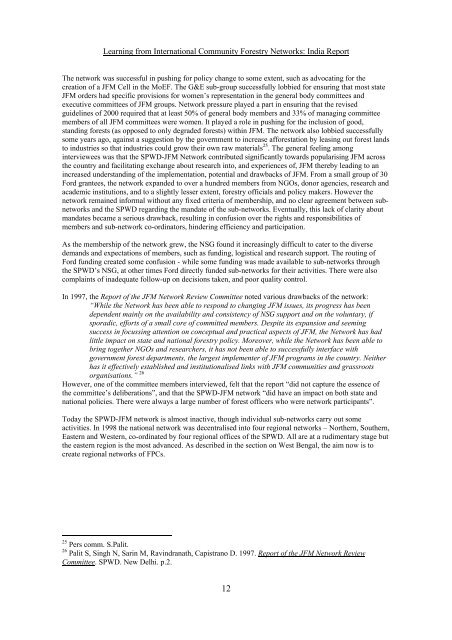Snapshots of International Community Forestry Networks: Country ...
Snapshots of International Community Forestry Networks: Country ...
Snapshots of International Community Forestry Networks: Country ...
Create successful ePaper yourself
Turn your PDF publications into a flip-book with our unique Google optimized e-Paper software.
Learning from <strong>International</strong> <strong>Community</strong> <strong>Forestry</strong> <strong>Networks</strong>: India Report<br />
The network was successful in pushing for policy change to some extent, such as advocating for the<br />
creation <strong>of</strong> a JFM Cell in the MoEF. The G&E sub-group successfully lobbied for ensuring that most state<br />
JFM orders had specific provisions for women’s representation in the general body committees and<br />
executive committees <strong>of</strong> JFM groups. Network pressure played a part in ensuring that the revised<br />
guidelines <strong>of</strong> 2000 required that at least 50% <strong>of</strong> general body members and 33% <strong>of</strong> managing committee<br />
members <strong>of</strong> all JFM committees were women. It played a role in pushing for the inclusion <strong>of</strong> good,<br />
standing forests (as opposed to only degraded forests) within JFM. The network also lobbied successfully<br />
some years ago, against a suggestion by the government to increase afforestation by leasing out forest lands<br />
to industries so that industries could grow their own raw materials 25 . The general feeling among<br />
interviewees was that the SPWD-JFM Network contributed significantly towards popularising JFM across<br />
the country and facilitating exchange about research into, and experiences <strong>of</strong>, JFM thereby leading to an<br />
increased understanding <strong>of</strong> the implementation, potential and drawbacks <strong>of</strong> JFM. From a small group <strong>of</strong> 30<br />
Ford grantees, the network expanded to over a hundred members from NGOs, donor agencies, research and<br />
academic institutions, and to a slightly lesser extent, forestry <strong>of</strong>ficials and policy makers. However the<br />
network remained informal without any fixed criteria <strong>of</strong> membership, and no clear agreement between subnetworks<br />
and the SPWD regarding the mandate <strong>of</strong> the sub-networks. Eventually, this lack <strong>of</strong> clarity about<br />
mandates became a serious drawback, resulting in confusion over the rights and responsibilities <strong>of</strong><br />
members and sub-network co-ordinators, hindering efficiency and participation.<br />
As the membership <strong>of</strong> the network grew, the NSG found it increasingly difficult to cater to the diverse<br />
demands and expectations <strong>of</strong> members, such as funding, logistical and research support. The routing <strong>of</strong><br />
Ford funding created some confusion - while some funding was made available to sub-networks through<br />
the SPWD’s NSG, at other times Ford directly funded sub-networks for their activities. There were also<br />
complaints <strong>of</strong> inadequate follow-up on decisions taken, and poor quality control.<br />
In 1997, the Report <strong>of</strong> the JFM Network Review Committee noted various drawbacks <strong>of</strong> the network:<br />
“While the Network has been able to respond to changing JFM issues, its progress has been<br />
dependent mainly on the availability and consistency <strong>of</strong> NSG support and on the voluntary, if<br />
sporadic, efforts <strong>of</strong> a small core <strong>of</strong> committed members. Despite its expansion and seeming<br />
success in focussing attention on conceptual and practical aspects <strong>of</strong> JFM, the Network has had<br />
little impact on state and national forestry policy. Moreover, while the Network has been able to<br />
bring together NGOs and researchers, it has not been able to successfully interface with<br />
government forest departments, the largest implementer <strong>of</strong> JFM programs in the country. Neither<br />
has it effectively established and institutionalised links with JFM communities and grassroots<br />
organisations.” 26<br />
However, one <strong>of</strong> the committee members interviewed, felt that the report “did not capture the essence <strong>of</strong><br />
the committee’s deliberations”, and that the SPWD-JFM network “did have an impact on both state and<br />
national policies. There were always a large number <strong>of</strong> forest <strong>of</strong>ficers who were network participants”.<br />
Today the SPWD-JFM network is almost inactive, though individual sub-networks carry out some<br />
activities. In 1998 the national network was decentralised into four regional networks – Northern, Southern,<br />
Eastern and Western, co-ordinated by four regional <strong>of</strong>fices <strong>of</strong> the SPWD. All are at a rudimentary stage but<br />
the eastern region is the most advanced. As described in the section on West Bengal, the aim now is to<br />
create regional networks <strong>of</strong> FPCs.<br />
25 Pers comm. S.Palit.<br />
26 Palit S, Singh N, Sarin M, Ravindranath, Capistrano D. 1997. Report <strong>of</strong> the JFM Network Review<br />
Committee. SPWD. New Delhi. p.2.<br />
12

















![CynefinFramework final [Read-Only]](https://img.yumpu.com/19017304/1/190x135/cynefinframework-final-read-only.jpg?quality=85)